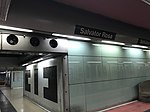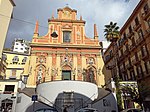The Petraio is a lineal urban neighborhood and pedestrian road in Naples, Italy. It descends from what was once an expansive upper agricultural area (the present day hilltop district of Vomero) and connects adjacent neighborhoods to downtown Naples — terminating just outside the original perimeter walls of Naples, near the present day Chiaia district.
The path arose from an ancient self-formed alluvial channel that followed a natural and narrow watercourse, deposting rocks, stones and pebbles; meandering and bifurcating as it descended. As it became trafficked, inhabited and developed, the path was improved to connect a rustic series of paved stone gradini (steps), discese (descending steps), vici (alleys), largi (widenings), rampe (ramps) and salite (climbs) — varying in slope and width — and framed by buildings, churches,and small businesses.As one of Naples' roughly more than 200 neighborhood stairs, inclined walks and ramps, the Petraio is accessible only on foot, and is noted for its range of architecture — from Neapolitan Liberty villas to bassi, small one and two room dwellings directly accessed off the Petraio itself — as well as its picturesque character and broad views of the city, the Gulf of Naples, Sorrento and the isle of Capri.
Originally, called il Imbrecciata (the debris-field) and later O'Petraro, the Petraio takes its name from the paths's original rocky character — the word stone translating to pietra in Italian and petra in Neapolitan.












